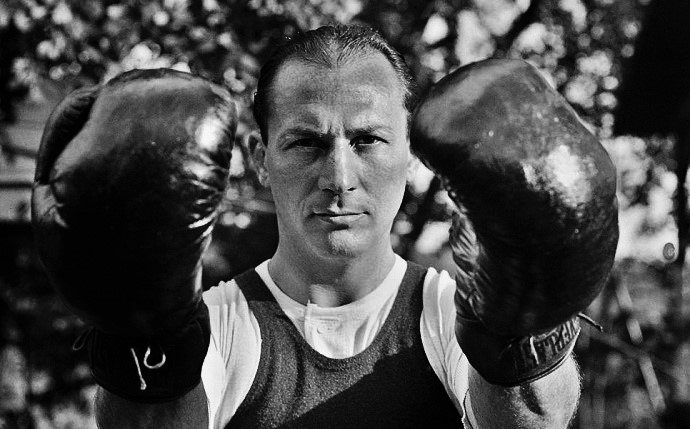Lightweight Champion, Benny Leonard announced his
retirement from boxing.
At that date, Leonard had already been boxing for 14
years, had been champion for almost 8 years and had engaged in 181 professional
fights.
181 fights in 14 years averages to one professional
fight per month.
The actual calendar shows that to be around the
correct mark—with some tics on the little more than a month side of the ledger,
and some tics in the more than 2 fights inside a month side of the ledger.
Now, stop for a moment and think about what you just
read.
We’re not talking 1 sparring session a month.
We’re talking about 1 bona fide professional fight per
month in an era packed with hot and heavy talent.
There were no multiple boxing organizations to spread
the titles around and water down the talent pool with “So and so is ranked 3rd
in this organization, but only 11th in this one and…”
Nope, none of that statistical tweaking noise.
Each weight class had a single apex, a single belt, a
single title to shoot for.
Every fighter had their eyes on THE Top. A definable
top at that.
All knew where they stood.
They stood in a jungle of hungry fighters competing
for the same pie.
Lest one think Benny Leonard was exceptional [and he
was, as a fighter] we are using Mr. Leonard’s retirement as a jumping off
point.
Again, he retired on January 15, 1925.
Within days the New York State Athletic Commission
announces a tournament to fill this Lightweight Champion vacancy.
Invitations were sent to the 20 top contenders.
20? That’s a helluva field, right?
Hold on, the Commission didn’t stop there.
The title was a world title, so they also invited to
participate champions from England, Canada, Mexico, Cuba, and Chile.
So, our field rapidly expands from that starting Top
20 cream of the US Crop.
In total, more than 50 competitors took part in this
tournament to determine the new champion.
That date again: January
15, 1925
By February promoters had already lined up the first
fights of what was to be a round robin style elimination series.
A Pause for Consideration
·
Consider Mr. Leonard’s career work rate.
·
Compare it to any champion today, be it
boxing or MMA.
·
Conjure the last time a present-day
champion retired.
·
Now conjure how long it took to get the choosing
of the next champ off the ground.
·
Let alone imagine using something so
democratic as an actual levelling of the playing field with the Top 20 best in the
field let alone the invitation additions from around the world.
·
Politics and marketing so delay and
pervert the current state of affairs today that championships can go vacant for
far longer and the tourney to choose the next champ is often limited to a few
behind-the-door shufflings of this or that not-quite-top-tier-and-let’s-avoid-a-few-fighters-if-we-can
wranglings.
Back to Mr. Leonard, was
his work rate an aberration?
First…
Were most fighters working then at rates similar to
today?
Let us compare today’s current heavyweight champions.
The current champion in the WBA, WBO, and WBC organizations
is Oleksandr Usyk.
He has had a total of 23 professional fights.
The current IBF heavyweight champion is Daniel Dubois.
Mr. Dubois has had 24 professional fights.
Again, back to Mr. Leonard, was his work rate an
aberration?
In the lightweight tourney of 1925, among the competitors
were…
·
George “KO” Chaney with 191 professional
bouts.
·
Sammy Mandell 77.
·
Jimmy Goodrich 122.
·
Eddie “Kid” Wagner 63.
·
Tommy O’Brien 75.
·
Joe Benjamin 101.
·
Benny Valgar 126.
·
Jack Berstein 80.
·
Ace Hudkins 40.
·
Solly Seeman 44.
I repeat our current World Champion[s] stand at 23 and
24 total fights respectively.
Back to the tournament.
It was not without problems.
Any field that large in a game as competitive as
actual fighting, there are bound to be.
You’ve got a few unpopular decisions [2], a few
winners who had to pull-out due to injury, and two top contenders who declined
to enter: Sid Terris and Johnny Dundee, but to be fair they chose not to go for
the pie, so…
Problems aside, can you imagine a more level way to
determine who gets the crown?
Anyway, to stay on our theme of work rate, on July 13, 1925, at Madison Square Garden in Buffalo, Jimmy Goodrich stopped Stanislaus Loayza of Chile in the second to be crowned the new lightweight champ.
Look at the date of that tourney
conclusion: July 13. 1925.
Benny Leonard retired on January 15, 1925.
50 + fighters are invited to brawl.
6 months later we have a new champ.
That is evidence of work rate.
And…recall this was a round robin.
Each fighter who won an advance had to fight again in
hopes of keeping that advance alive.
By the time we get to the July 13th final
fight our top two competitors had fought a combined 11 times versus other
top-tier hungry foes for this opportunity.
Mr. Leonard’s work rate was not an anomaly.
There was a time when fighters fought, and they fought
a lot, and they fought a capital T tough cadre at that.
Many pros fought more than many people train today.
Work rate is but one way to determine toughness, but I
think its safe to say as far as this metric goes—these Men of Yore Win The
Tough Crown Here.
To train like this Hosses of Yore, see our Boxing Like the Champs
Programs and Street
Dentist material in The Black Box Project.
Hell, consider joining the Crew of like-minded cadre
who see the merit in walking the exact steps of these Hosses of Yore.
Details here.
For more on Old-School Tough see this historical essay
[for free, kids.]
A
Master Trainer on Training for Toughness
Resources for Livin’ the Warrior Life
https://www.extremeselfprotection.com/
The Indigenous Ability Blog

Comments
Post a Comment